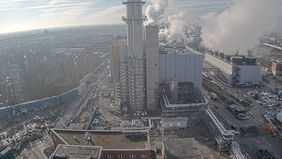
Herne CCGT generates its first electricity
Herne/Essen. STEAG’s new combined cycle gas turbine power plant in Herne reached another milestone on the way to going into service in early summer this year: In the past few days, the power plant was synchronized with the electricity grid and fed electricity into the grid for the first time. The gradual commissioning and the testing required for this will continue in the coming days as output gradually increases.
The major project for the new and highly efficient combined cycle gas turbine power plant in Herne is making great strides towards its successful completion. “We are very proud that this demanding project, which is particularly challenging under pandemic conditions, is still on schedule. The milestone now reached with the first supply from the plant into the power grid is an impressive confirmation of this,” says Dr. Andreas Reichel, the new Chairman of STEAG’s Board of Management, expressing his delight at the good news heralding in the year.
Start-up of the gas turbine at the end of December
After the natural gas supply had been put into operation in September 2021, the gas turbine at the new power plant was started up for the first time at the end of December that year. “Everything went as planned, so grid synchronization and the first electricity feed into the grid were the logical next steps,” says Kai Braekler, who is the responsible project manager at STEAG for construction of the new power plant. On January 19, we reached 260 megawatts (MW) – which corresponds to about 40 percent of the maximum output. In the process, the blowing out and cleaning of the steam pipework is currently taking place.
Once this has been done, the heat extraction system of the Herne CCGT power plant will finally be put into service on a trial basis. “This is planned for February, statistically one of the coldest months of the year with a correspondingly high demand for heat,” says Kai Braekler. When it is in service, the Herne CCGT power plant will produce not only electricity but also heat in a combined heat and power (CHP process). In future, the amount of heat produced will be sufficient to supply climate-friendly district heating for up to 275,000 households in the Ruhr region.
Greatly improved carbon footprint
The conversion of electricity and heat generation from hard coal to natural gas significantly improves the emissions balance at the Herne site. “In the future, we will permanently save at least 50 percent of CO2 emissions,” reports Dr. Ralf Schiele, who is responsible for the Market and Technology divisions on the STEAG Management Board. This is possible for two reasons: “Firstly, natural gas releases less CO2 when burned than hard coal. And secondly, the efficiency of the new plant has improved enormously once again compared with the Herne 4 hard coal unit, especially when electricity and heat are generated simultaneously,” says Ralf Schiele.
Siemens Energy as EPC contractor
The new combined cycle gas turbine power plant in Herne is being built by Siemens Energy as the engineering, procurement and construction (EPC) contractor. “Even though putting into service is still outstanding, it can already be said with a view to the past 24 months that the project has gone very well, especially under the special conditions of the coronavirus pandemic. Without question, this is also the result of the good cooperation and mutual trust between Siemens Energy and STEAG, and the high level of personal commitment of the colleagues involved from many different countries,” says STEAG project manager Kai Braekler.
Herne CCGT ready for hydrogen future
But it is not only the good cooperation that is a cause for celebration. The engineering systems installed in Herne also ensure that the new combined cycle power plant is more than just bridging technology on the way to a renewable and climate-neutral energy future, because, “The new power plant is already able to co-combust up to 15 percent hydrogen when it is added to the natural gas network,” says STEAG Director Andreas Reichel. In perspective, after a successful ramp-up of the hydrogen economy, it would also be possible to upgrade the plant and convert it completely to hydrogen firing. “We see STEAG at the Herne site as being optimally equipped not only for the energy industry and technical challenges of tomorrow, but also for the day after tomorrow,” Andreas Reichel concludes.
